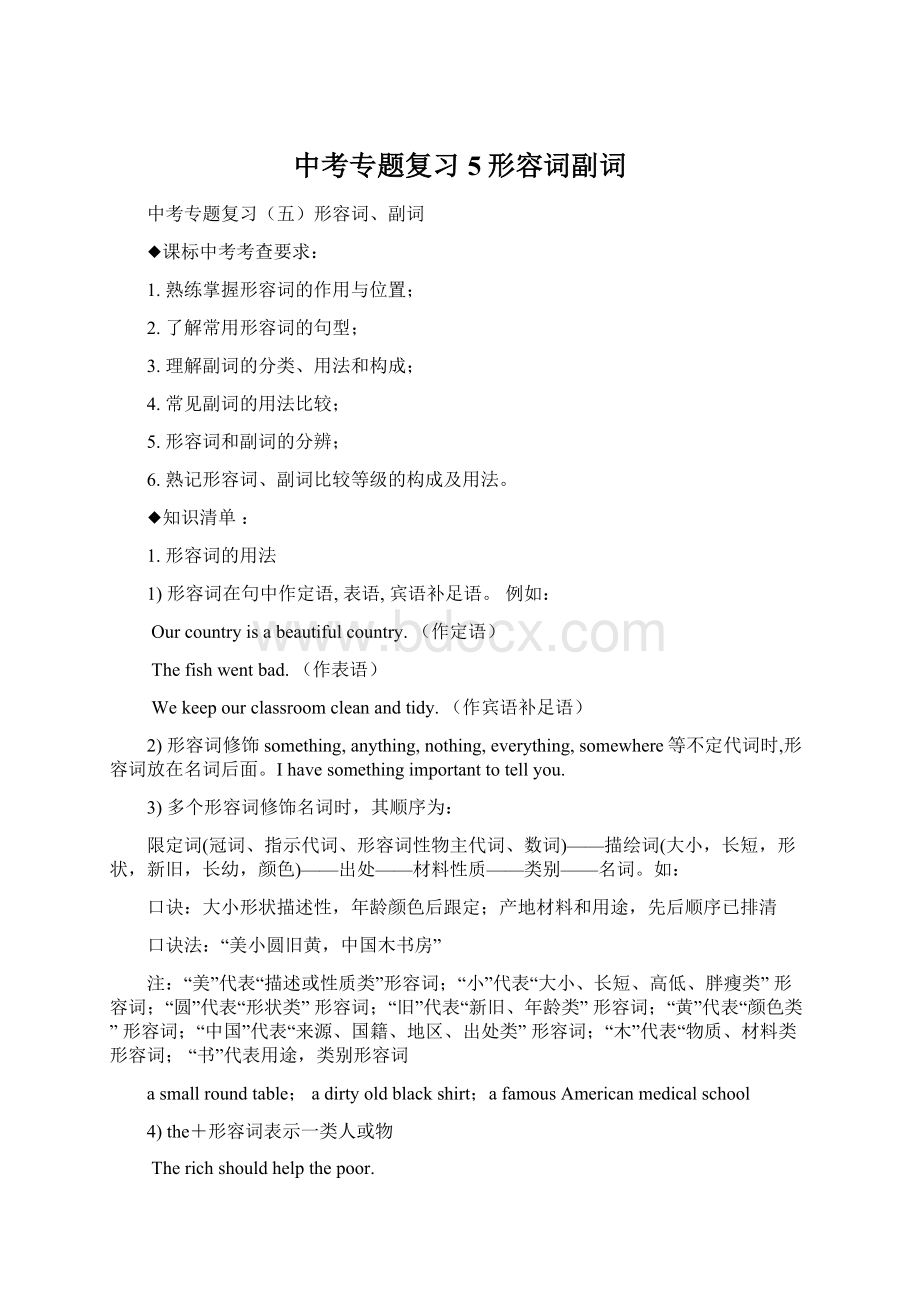中考专题复习5形容词副词.docx
《中考专题复习5形容词副词.docx》由会员分享,可在线阅读,更多相关《中考专题复习5形容词副词.docx(13页珍藏版)》请在冰豆网上搜索。

中考专题复习5形容词副词
中考专题复习(五)形容词、副词
◆课标中考考查要求:
1.熟练掌握形容词的作用与位置;
2.了解常用形容词的句型;
3.理解副词的分类、用法和构成;
4.常见副词的用法比较;
5.形容词和副词的分辨;
6.熟记形容词、副词比较等级的构成及用法。
◆知识清单:
1.形容词的用法
1)形容词在句中作定语,表语,宾语补足语。
例如:
Ourcountryisabeautifulcountry.(作定语)
Thefishwentbad.(作表语)
Wekeepourclassroomcleanandtidy.(作宾语补足语)
2)形容词修饰something,anything,nothing,everything,somewhere等不定代词时,形容词放在名词后面。
Ihavesomethingimportanttotellyou.
3)多个形容词修饰名词时,其顺序为:
限定词(冠词、指示代词、形容词性物主代词、数词)——描绘词(大小,长短,形状,新旧,长幼,颜色)——出处——材料性质——类别——名词。
如:
口诀:
大小形状描述性,年龄颜色后跟定;产地材料和用途,先后顺序已排清
口诀法:
“美小圆旧黄,中国木书房”
注:
“美”代表“描述或性质类”形容词;“小”代表“大小、长短、高低、胖瘦类”形容词;“圆”代表“形状类”形容词;“旧”代表“新旧、年龄类”形容词;“黄”代表“颜色类”形容词;“中国”代表“来源、国籍、地区、出处类”形容词;“木”代表“物质、材料类形容词;“书”代表用途,类别形容词
asmallroundtable;adirtyoldblackshirt;afamousAmericanmedicalschool
4)the+形容词表示一类人或物
Therichshouldhelpthepoor.
5)形容词常用句型
A.“It’s+adj.+of+sb.+todo”表示“某人(做某事)怎么样”。
注意:
这一句型中常用描述行为者的性格、品质的形容词,如good(好的),kind(友善的),nice(友好的),polite(有礼貌的),clever(聪明的),foolish(愚蠢的),lazy(懒惰的),careful(细心的),careless(粗心的),right(正确的),wrong(错误的)等。
It’sverykindofyoutohelpme.(=Youareverykindtohelpme.)
It’sfoolishofhimtogoalone.(=Heisfoolishtogoalone.)
B.“It’s+adj.+for+sb.+todo”表示“做某事对某人来说怎么样”。
注意:
这一句型中常用的形容词有important(重要的),necessary(必要的),difficult(困难的),easy(容易的),hard(艰难的),dangerous(危险的),safe(安全的),useful(有益的),pleasant(舒适的),interesting(有趣的),impossible(不可能的)等。
It’snoteasyforthemtolearnaforeignlanguage.(=Tolearnaforeignlanguageisnoteasyforthem.)
习题演练:
1.Ilike____Benz(奔驰)car.
A.beautifullittleoldblackhisB.blackhislittleoldbeautiful
C.hisbeautifulblacklittleD.hisbeautifullittleblack
2.LastSunday,hepickedupa____umbrella.
A.blackheavysteelChineseB.blacksteelheavyChinese.
C.heavyblacksteelChineseD.heavyblackChinesesteel
3.Theyboughttheirdaughter____handbagsasherbirthdaypresent.
A.twoShanghaileathersmallblackB.twoleathersmallblackShanghai
C.twosmallblackShanghaileatherD.twoblacksmallShanghaileather
4.Theoldladygoestothe____churcheverySunday.
A.pleasingoldEnglishB.oldpleasingEnglish
C.EnglisholdpleasingD.pleasingEnglishold
5.--WhichoneofthosegirlsisJack'ssister?
--Theonewhoiswearing_____skirt.
A.aprettywhitesilkB.awhitesilkpretty
C.asilkprettywhiteD.aprettysilkwhite
2.副词的用法
1)副词在句中可作状语,表语。
Hestudiesveryhard.(作状语)
Whenwillyoubeback?
(作表语)
副词按其用途和含义可分为下面五类:
A.时间副词
常见的时间副词有:
nowtoday,tomorrow,yesterday,before,late,early,never,seldom,sometimes,often,usually,always(频率)等。
B.地点副词
常见的地点副词有:
here,there,inside,outside,home,upstairs,downstairs,anywhere,everywhere,nowhere,somewhere,down,up,off,on,in,out等。
.
C.方式副词
方式副词一般都是回答“怎样的?
”这类问题的,常见的方式副词有:
anxiously(不安的,焦虑的),badly,bravely,calmly,carefully,proudly,rapidly,suddenly,successfully,angrily,happily,slowly,warmly,well,fast,slow,quick,hard,alone,high,straight,wide等。
D.程度副词
程度副词多数用来修饰形容词和副词,有少数用来修饰动词或介词短语。
常见的程度副词有:
much,(a)little,abit,very,so,too,enough,quite,rather,pretty,greatly,completely,nearly,almost,deeply,hardly,partly(部分地)等。
E.疑问副词是用来引导特殊疑问句的副词。
常见的疑问副词有:
how,when,where,why等。
2).副词在句中的位置
A.多数副词作状语时放在动词之后。
如果动词带有宾语,则放在宾语之后。
例如:
Mr.Smithworksveryhard.
B.频度副词作状语时,通常放在行为动词之前,助动词之后。
例如:
I’veneverheardhimsinging.
Sheisseldomill.
C.程度副词一般放在所修饰的形容词和副词的前面,但enough作副词用时,通常放在被修饰词的后面。
例如:
Aratherdifficultjob.
runsveryfast;hardenough
3).部分常用副词的用法
A.very,much
这两个副词都可表示“很”,但用法不同。
Very用来修饰形容词和副词的原级,而much用来修饰形容词和副词的比较级。
例如:
verynice/muchbetter/muchmorequickly
Much可以修饰动词,而very则不能。
例如:
Theydidnottalkmuch.
B.also,too,aswell与either的区别
肯定句中also,aswell,tooalso常用于助动词之后,行为动词之前;aswell,too用于句末;either用于否定句中,置于句末。
例如:
Myfatherisateacher.Mymotherisalsoateacher.
=Myfatherisateacher.Mymotherisateacheraswell.
=Myfatherisateacher.Mymotherisateacher,too.
Ican’tspeakFrench.Jennycan’tspeakFrench,either.
C.already,yet
already一般用于语肯定句,和完成时连用,yet一般用于否定句。
D.so,neither
表示主语也是和上面句子的主语同样的情况:
So+助动词+主语(肯定形式)Neither+助动词+主语(否定形式)
表示主语确实如此,真的是这样:
So+主语+助动词
E.so与such的区别
⑴So+adj./adv.
So+adj.+a/an+可数名词单数.
Somany/fewflowerssolittle(表数量)/muchbread
So…that(引导结果状语)/sothat(引导目的状语)
⑵Such+a/an+adj.+可数名词单数
Such+adj.+不可数名词
Such+adj.+可数名词复数
Allsuchpossibilities,Onesuchdictionary,somesuchcards,severalsuchpaintings,anothersuchaccident,manysuchpeople,nosuchbook=notsuchabook
Such…that(引导结果状语)
F.sometime,sometimes,sometime与sometimes的区别
sometime:
某一时间,某一时刻,将来时,过去时都可
sometimes:
有时,不时的
sometime:
一段时间,for+sometime
sometimes:
几次,几倍
例:
We’llhaveatestsometimenextmonth.
Sometimeswearebusyandsometimeswearenot.
HestayedinBeijingforsometimelastyear.
IhavebeentoBeijingsometimes.
G.ago与before的区别
ago常用于过去时
before指过去或将来的某时刻“以前”,也可泛指以前,常和完成时连用,可以单独使用。
例如:
Isawhimtenminutesago.
Hetoldmethathehadseenthefilmbefore.
H.now,just与justnow的区别
now:
与一般现在时、现在进行时、现在完成时连用,意为“现在”
just:
与完成时连用,表示“刚……”
justnow:
和过去时连用,表示“刚才”
Wehavejustseenthefilm.
4).兼有两种形式的副词
A.close与closely
close意思是"近地";closely意思是"仔细地"修饰动词
Heissittingclosetome.
Watchhimclosely.
B.late与lately
Youhavecometoolate("晚").
Whathaveyoubeendoinglately?
("最近")
C.deep与deeply
deep意思是"深",表示空间深度;deeply时常表示感情上的深度,"深深地"
Hepushedthestickdeepintothemud.
Evenfatherwasdeeplymovedbythefilm.
D.high与highly
high表示空间高度;highly表示程度,相当于much
Theplanewasflyinghigh.
Hespokehighlyofyouropinion.
E.wide与widely
wide表示空间宽度;widely意思是"广泛地","在许多地方"
Heopenedthedoorwide.
Englishiswidelyusedintheworld.
F.hard与hardly
hard的意思是“刻苦地”;hardly的意思是“几乎不”,表示否定
Healwaysworkshard.
Icanhardlybelievemyeyes.
G.near与nearly
near的意思是“靠近、接近”;nearly的意思是“将近,差不多”
3.形容词,副词的比较级、最高级
1)比较等级的构成
A.规则变化
单音节词和少数双音节词,加词尾-er,-est来构成比较级和最高级。
构成法
原级
比较级
最高级
一般单音节词未尾加-er,-est
tall(高的)
taller
tallest
以不发音的e结尾的单音词和少数双音节词只加-r,-st
nice(好的)
nicer
nicest
以一个辅音字母结尾的闭音节单音节词,双写结尾的辅音字母,再加-er,-est
big(大的)
bigger
biggest
"以辅音字母+y"结尾的双音节词,改y为i,再加-er,-est
easy(容易的)
easier
easiest
少数以-er,-ow结尾的双音节词未尾加-er,-est
narrow(窄的)
narrower
narrowest
其他双音节词和多音节词,在前面加more,most
important(重要的)
moreimportant
mostimportant
B.不规则变化
good(好的)betterbest;well(健康的)betterbest;
bad(坏的)worseworst;ill(有病的)worseworst
old(老的)older/elderoldest/eldest;much/many(多的)moremost;
little(少的)lessleast;far(远的)farther/furtherfarthest/furthest
2)形容词,副词等级的用法
原级的用法
A.只能修饰原级的词,very,quite,so,too
tootired,quitegood…
B.原级常用的句型结构
(1)“甲+动词+(倍数)+as+形容词、副词原级+as+乙”表示“甲和乙程度相同”或“甲是乙的几倍”AisasgoodasB;(A和B一样好)
ArunstwotimesasfastasB(A跑步的速度是B的两倍)
(2)“甲+动词+not+as/so+形容词、副词原级+as+乙”甲不如乙…
Aisnotas/sogoodasB(A不如B那么好)
Arunsnotas/sofastasB(A跑的没有B那么快)
比较级的用法
A.可以修饰比较级的词,much,alot,far(…的多),alittle,abit(…一点儿),even(甚至),still(仍然)。
B.比较级常用的句型结构
(1)“A+动词+(倍数)+形容词、副词比较级+than+B”表示“A比B…”或“A比B…几倍”
AisbetterthanB;A比B好
ArunstwotimesfasterthanBA跑步比B快2倍
(2)“A+动词+形容词、副词比较级+than+anyother+单数名词(+介词短语)”“A最……”。
TheYangtzeRiverislongerthananyotherriverinChina.
=TheYangtzeRiveristhelongestriverinChina.
(3)“A+动词+the+形容词、副词比较级+ofthetwo+……”表示“A是两者中较……的”。
Lookatthetwoboys.Mybrotheristhetallerofthetwo.
(4)“比较级+and+比较级”表示“越来越……”。
Heisgettingtallerandtaller.
Theflowersaremoreandmorebeautiful.
(5)“the+比较级,the+比较级”表示“越……,越……”。
Themorecarefulyouare,thefewermistakesyou’llmake.
(6)“特殊疑问词+be+形容词比较级,AorB?
”
Whichisbigger,theearthorthemoon?
“特殊疑问词+实意动词+副词比较级,AorB?
”
Whodrawsbetter,JennyorDanny?
最高级常用句型结构
(1)“主语+动词+the+形容词、副词最高级+单数名词+in/of短语”表示“……是……中最……的”。
Tomisthetallestboyinhisclass./ofallthestudents.
(2)“主语+be+oneofthe+形容词最高级+复数名词+in/of短语”表示“……是……中最……之一”。
BeijingisoneofthelargestcitiesinChina.
(3)“特殊疑问词+动词+the+最高级+A,B,orC?
”
Whichcountryisthelargest,China,BrazilorCanada?
◆历年真题
1.---Howoldisthebaby?
---Heis______.
A.six-months-oldB.six-month-oldC.six-montholdD.sixmonthsold
2.—ThereisasmileonMissGao’sface.Shemustbe_____withSam’swork.
—Ithinkso.Noonedidas_____ashiminourclass.
A.angry;wellB.pleasing;goodC.strict;goodD.pleased;well
3.---Thisdishtastes_______.
---Thankyou.It_____byMr.Smith.
A.good,wascookedB.well,cooksCbad,iscookedD.terrible,cooked
4.Theteacherlookedatherstudents______whentheyweresaved.Wealsofelt_____forthem.
A.happily,happy B.happy,happily C.happy,happyD.happily,happily
5.---Travellingbyplaneis_____thantravellingbytrain.
---Yes,butitisnotso______astravellingbytrain.
A.quickly,cheaperB.morequick,cheaply
C.quick,morecheapD.quicker,cheap
6.---Mum,IthinkI’m______togetbacktoschool.
---Notreally,mydear.You’dbetter______athomeforanotherdayortwo.
A.sowell,stayB.sogood,tostay
C.wellenough,stayD.goodenough,tostay
7.---Thecakelooks__________---Yes,andittasteseven________
A.well,good B.nice,better C.good,worse D.better,best
8.—________isyouropiniononthefilm“Avatar”?
—It’samazing!
Iwas________moved.
A.What,deepB.How,deepC.What,deeplyD.How,deeply
10.---Youplaythepianosowell._____doyouhavethepianolessons?
---Onceaweek.
A.HowsoonB.HowoftenC.HowlongD.Howmuch
11.---Excuseme,Sir.______isitfromheretoGuangzhou?
---It’sabout_______drive.
A.Howlong,twohour’sB.Howfar,twohours’
C.Howfar,two-hourD.Howlong,twohour
12.---______willyoutraveltoSh